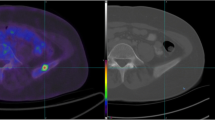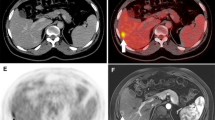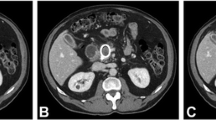Abstract
Background: We assessed the contribution of dedicated computed tomographic (CT) interpretation to the accuracy of positron emission tomography (PET) plus CT in imaging patients with suspected primary or metastatic colorectal carcinoma.
Methods: One hundred PET/CT scans in 90 consecutive patients were evaluated retrospectively. Imaging was performed on a GE Discovery LS PET/CT scanner. PET images were obtained from the skull base through the midthigh after intravenous administration of 15 to 20 mCi of [18F] fluorine-18-fluoro-2-deoxyglucose. Noncontrast axial CT images were obtained at the same anatomic locations, with 140 kV, 80 mA, 0.8 s/CT rotation, a pitch of 6, and a table speed of 22.5 mm/s. The CT component of the PET/CT study was reviewed independently by consensus of two blinded readers. Scans were evaluated for the presence of primary disease, local recurrence, and distant metastases. Results were compared with the PET/CT report. The gold standard was clinical and imaging follow-up for at least 6 months, surgery, or biopsy.
Results: The study included 40 males and 50 females, with a mean age of 63 years (range, 31–92 years). The indications for the examination were to evaluate for recurrence of colorectal cancer in 83 cases, determine disease spread in 15 cases, and evaluate for possible primary malignancy in two cases with rising carcinoembryonic antigen. Sensitivity, specificity, and accuracy of the PET/CT report and of the combined PET/CT with dedicated CT interpretation were 0.914, 0.633, and 0.830 and 0.986, 1.000, and 0.980, respectively. The difference between PET/CT and the combined PET/CT with dedicated CT interpretation with respect to accuracy was statistically significant (p < 0.05).
Conclusion: The CT portion of PET/CT provides valuable anatomic and pathologic information to the functional information provided by PET and helps improve the overall accuracy of the combined study.




Similar content being viewed by others
References
PH Sugarbaker (1990) ArticleTitleSurgical decision making for large bowel cancer metastatic to the liver Radiology 174 621–626 Occurrence Handle1:STN:280:By%2BC287gvVU%3D Occurrence Handle2406776
MR Paley PR Ros (1998) ArticleTitleHepatic metastases Radiol Clin North Am 36 349–363 Occurrence Handle1:STN:280:DyaK1c7otFKjtg%3D%3D Occurrence Handle9520987
LT Jenkins KW Millikan SD Bines et al. (1997) ArticleTitleHepatic resection for metastatic colorectal cancer Am Surg 63 605–610 Occurrence Handle1:STN:280:ByiA2cnhtFA%3D Occurrence Handle9202534
A Holm E Bradley JS Aldrete (1989) ArticleTitleHepatic resection of metastasis from colorectal carcinoma. Morbidity, mortality, and pattern of recurrence Ann Surg 209 428–434 Occurrence Handle1:STN:280:BiaC1M3lvFU%3D Occurrence Handle2930288
RH Huebner KC Park JE Shepherd et al. (2000) ArticleTitleA meta-analysis of the literature for whole-body FDG PET detection of recurrent colorectal cancer J Nucl Med 41 1177–1189 Occurrence Handle1:STN:280:DC%2BD3czpslemtw%3D%3D Occurrence Handle10914907
PD Shreve Y Anzai RL Wahl (1999) ArticleTitlePitfalls in oncologic diagnosis with FDG PET imaging: physiologic and benign variants Radiographics 19 61–77 Occurrence Handle1:STN:280:DyaK1M7it1yjsw%3D%3D Occurrence Handle9925392
MH Whiteford HM Whiteford LF Yee et al. (2000) ArticleTitleUsefulness of FDG-PET scan in the assessment of suspected metastatic or recurrent adenocarcinoma of the colon and rectum Dis Colon Rectum 43 759–767 Occurrence Handle1:STN:280:DC%2BD3czhsFKjtA%3D%3D Occurrence Handle10859074
RL Wahl LE Quint RL Greenough et al. (1994) ArticleTitleStaging of mediastinal non-small cell lung cancer with FDG PET, CT, and fusion images: preliminary prospective evaluation Radiology 191 371–377 Occurrence Handle1:STN:280:ByuB3cvitVI%3D Occurrence Handle8153308
RL Wahl LE Quint RD Cieslak et al. (1993) ArticleTitle“Anatometabolic” tumor imaging: fusion of FDG PET with CT or MRI to localize foci of increased activity J Nucl Med 34 1190–1197 Occurrence Handle8315501
K Kalki SC Blankespoor JK Brown et al. (1997) ArticleTitleMyocardial perfusion imaging with a combined x-ray CT and SPECT system J Nucl Med 38 1535–1540 Occurrence Handle1:STN:280:DyaK1c%2FitFOnsw%3D%3D Occurrence Handle9379188
T Beyer DW Townsend T Brun et al. (2000) ArticleTitleA combined PET/CT scanner for clinical oncology J Nucl Med 41 1369–1379 Occurrence Handle1:STN:280:DC%2BD3cvitFCguw%3D%3D Occurrence Handle10945530
HC Steinert GK von Schulthess (2002) ArticleTitleInitial clinical experience using a new integrated in-line PET/CT system Br J Radiol 75 S36–S38 Occurrence Handle12519734
TJ Ruers BS Langenhoff N Neeleman et al. (2002) ArticleTitleValue of positron emission tomography with [F-18]fluorodeoxyglucose in patients with colorectal liver metastases: a prospective study J Clin Oncol 20 388–395 Occurrence Handle10.1200/JCO.20.2.388 Occurrence Handle1:STN:280:DC%2BD38%2FmtV2jtg%3D%3D Occurrence Handle11786565
V Kalff RJ Hicks RE Ware et al. (2002) ArticleTitleThe clinical impact of (18)F-FDG PET in patients with suspected or confirmed recurrence of colorectal cancer: a prospective study J Nucl Med 43 492–499 Occurrence Handle11937593
T Arulampalam D Costa D Visvikis et al. (2001) ArticleTitleThe impact of FDG-PET on the management algorithm for recurrent colorectal cancer Eur J Nucl Med 28 1758–1765 Occurrence Handle10.1007/s002590100646 Occurrence Handle1:CAS:528:DC%2BD3MXosFagurg%3D Occurrence Handle11734912
C Cohade M Osman HK Pannu RL Wahl (2003) ArticleTitleUptake in supraclavicular area fat (“USA-Fat”): description on 18F-FDG PET/CT J Nucl Med 44 170–176 Occurrence Handle1:CAS:528:DC%2BD3sXhsFygs7g%3D Occurrence Handle12571205
Author information
Authors and Affiliations
Rights and permissions
About this article
Cite this article
Kamel, I., Cohade, C., Neyman, E. et al. Incremental value of CT in PET/CT of patients with colorectal carcinoma. Abdom Imaging 29, 663–668 (2004). https://doi.org/10.1007/s00261-003-0163-2
Received:
Accepted:
Published:
Issue Date:
DOI: https://doi.org/10.1007/s00261-003-0163-2




